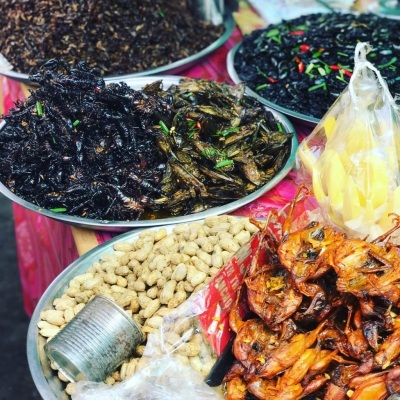
Would you like a side of Chapuline with your next meal?
Chapuline is a typical food found at Mexican local markets, chili flavoured fried grasshoppers eaten as a snack. This high protein, low fat, low environmental footprint on producing this food is being looked at as the ‘future’ for food.
A typical western diet consumes a large portion of meat with Australian’s consuming over 100kg per person per year. Our biggest consumption is poultry, followed by beef & veal, poultry, pig, and sheep meat. As with any food, there is work required to grow, develop, farm, and produce what we ingest. Along the production line is the people involved; farmers, transporters, shop owners, logistics, waiters, and chefs, there is also an impact on the earth in regards to our food consumption.
Research has shown it takes double the water to produce a serving size of meat compared to nuts, 100 times more land, and a meat diet produces 20 times more greenhouse gases than a comparable plant-based diet. For years different people have or have not eaten meat for a variety of reasons, and among our western society, I am sure you know someone vegetarian, vegan, or pescatarian.
What’s the impact?
Looking globally there is enough food to feed the world, yet unfortunately distribution and food security for the whole population are not as equitable as it should be. The consumption of food (and wastage) by some countries far outweighs the accessibility of other countries.
The impact on the food production process for meat-based diets far outweighs that for plant-based diets and research has been undertaken to look at how sustainable, low impact, high yield food sources can be accessed. This is where chapulines and a whole range of slightly ‘weird and wonderful’ alternatives are making their way from just research to plates.
Insects have been heralded as the new ‘food of the future’ with the UN promoting their consumption as a way to feed the expected 9 billion population to fill the globe by 2050. “A benefit of insects as an alternative animal protein source is that they can be reared sustainably on organic side streams (e.g. manure, pig slurry and compost).” UN. Whilst this might sound ‘icky’ at the thought of raising food sources on by-product; the impact on land clearing, water consumption and nutritional content for consumption might be the way of the future.

Kelp
Kelp, a common variety of seaweed, is used in many products we consume daily; toothpastes, shampoos, salad dressings, puddings, cakes, dairy products, frozen foods, and even pharmaceuticals. Algin, an emulsifying and binding agent is extracted from the seaweed and used in a variety of daily household items and food substances.
Kelp farming is an infrastructure that has already been used with the mentioned products above but is gaining more interest as a solution to land-based farming for animal livestock. Kelp takes up no land space and can grow in a variety of climates across the globe. A food source for some human consumption, kelp is also used for animal livestock feed, reducing water and land usage for meat production.
Kelp forests are studied throughout the world and they help contribute to balancing out CO2 levels in the atmosphere and regulating sea temperatures, an area of concern for those worried about climate change.
So what are you serving up?
What does this all mean? Are we now swapping out fries and burgers for kelp and crickets? Whilst study and research have been developed in this area and insects are consumed in a variety of cuisines globally, the trend to make Jimmy Cricket or the seaweed found on the beach part of our daily routine may take a little longer and more convincing of those whose diet consists of the typical >100kg per person per year consumption.
Maybe next time you are offered a fried snack or launch into your ice cream dessert, take a moment to think about where the origins of your culinary habits truly lie.

Kelly Thompson is the newest member of the Sports journalist team. Kelly currently plays AFL for Casey Demons in the VFLW, and practices what she preaches as a HOPE (Health, Outdoor, and Physical Education) Teacher in Melbourne’s southeast.